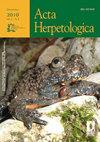Screening of Ophidiomyces ophidiicola in the free-ranging snake community annually harvested for the popular ritual of San Domenico e dei Serpari (Cocullo, AQ, Italy)
IF 0.9
4区 生物学
Q4 ZOOLOGY
引用次数: 0
Abstract
In the Abruzzi village of Cocullo (Italy), each year, on May 1st, local snake hunters (known as Serpari) display colubrids, captured in the wild, to commemorate the ancient ritual of San Domenico. The ascomycete Ophidiomyces ophidiicola (Oo) is the causative agent of ophidiomycosis, an emerging disease with sublethal effects. Skin lesions, such as dysecdysis, edematous, crusty or necrotic scales, swellings, nodules, and ulcers, are the most common clinical manifestation of the disease. The pathogen and its associated disease are well characterized in wild snakes in North America, whereas broad screenings of free ranging wild ophidians in Europe are rare. In 2019, as part of a multi-year snake health monitoring project, all the Cocullo ophidians were carefully examined for integumentary affections and those showing signs consistent with ophidiomycosis were dry swabbed on the skin and on any visible cutaneous lesions with a single applicator. The extracted DNA underwent a broad-range panfungal PCR targeting the D1-D2 region, as well as two conventional PCRs specific to the ITS2 and IGS regions of Oo DNA. Twenty-three out of 129 snakes (13/82 Elaphe quatuorlineata; 7/31 Hierophis viridiflavus; 3/15 Zamenis longissumus; 0/1 Natrix helvetica) resulted clinically affected, but no specific Oo genomic DNA was detected by PCR. The Cocullo ritual celebration provided a unique opportunity for the first systematic testing of a large sample size of a local snake community for the monitoring of this pathogen in Italy.在自由放养的蛇群落中筛选Ophidiomyces ophidiicola,每年为圣多梅尼科·德伊塞尔帕里(意大利AQ,科库洛)的流行仪式采集
在科库洛(意大利)的阿布鲁齐村,每年的5月1日,当地的捕蛇者(被称为Serpari)都会展示在野外捕获的colubrid,以纪念圣多梅尼科的古老仪式。子囊菌Ophidiomyces ophidicola(Oo)是一种新出现的具有亚致死作用的疾病Ophidiomicsis的病原体。皮肤病变,如蜕皮障碍、水肿、结皮或坏死的鳞屑、肿胀、结节和溃疡,是该疾病最常见的临床表现。这种病原体及其相关疾病在北美的野生蛇中有很好的特征,而在欧洲,对自由放养的野生蛇类进行广泛筛查是罕见的。2019年,作为一个多年蛇健康监测项目的一部分,所有的Cocullo ophidians都被仔细检查了表皮的影响,那些表现出与ophidomycosis一致迹象的人用一个涂抹器在皮肤和任何可见的皮肤损伤上进行了干拭子。提取的DNA进行了针对D1-D2区域的宽范围全真菌PCR,以及Oo DNA的ITS2和IGS区域特异的两种常规PCR。129条蛇中有23条受到了临床影响(13/82条四氏Elaphe quatourlinata;7/31条绿色嗜热菌;3/15条长吻Zamenis longissums;0/1条Natrix helvetica),但PCR未检测到特定的Oo基因组DNA。科库洛仪式庆典为首次对意大利当地蛇群落的大样本量进行系统测试以监测这种病原体提供了一个独特的机会。
本文章由计算机程序翻译,如有差异,请以英文原文为准。
求助全文
约1分钟内获得全文
求助全文
来源期刊

Acta Herpetologica
ZOOLOGY-
CiteScore
1.20
自引率
12.50%
发文量
10
审稿时长
6 months
期刊介绍:
Acta Herpetologica, a journal open to academics all over the world, offers itself as a new site for the presentation and discussion of the most recent results in the field of research on Amphibians and Reptiles, both living and extinct. The official journal of the Societas Herpetologica Italica (S.H.I.), Acta Herpetologica publishes original works – extended articles, short notes and book reviews – mostly in English, dealing with the biology and diversity of Amphibians and Reptiles.
 求助内容:
求助内容: 应助结果提醒方式:
应助结果提醒方式:


